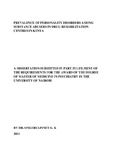| dc.description.abstract | Introduction: Personality disorders playa potential role in vulnerability to substance misuse
and dependence. Very little information is available on the co-occurrence of different
personality disorders (PDs) and drug use disorders among treatment seeking substance
abusers in the Kenyan population. Numerous studies in both population and clinic based
settings show a higher prevalence of personality disorders among individuals with substance
use disorders than among the general population, with particular prominence of antisocial and
border line personality disorder. The high individual and social costs of drug use highlight the
need to study factors related to such behaviours. Personality disorder effects can have
important clinical implications. Research on the correlates of drug addiction provides
insights for understanding aetiology and informs prevention and cessation programs. The
present study contributes to this line of research by examining personality disorders associated with
substance abuse.
Aim: The aim of the study was to establish the prevalence of personality disorders among
substance abusers and to identify factors associated with the presence of personality
disorders.
Study design: A cross-sectional descriptive study.
Study site: The study was conducted in the following drug rehabilitation centres in Kenya:
Mathari Hospital Rehabilitation Centre, Asumbi Treatment Centres, Red Hill Rehabilitation
Centre, Script Resource Centre, Blessed Talbot Rehabilitation centre, Maisha Rehabilitation
Centre.'
Method: A sample of207 patients admitted in drug rehabilitation centres in Kenya was
assessed within a period of three months. Informed consent was sought from the patients.
Individual screening for inclusion criteria followed and recruitment was done for patients
who met the inclusion criteria. A socio demographic questionnaire was administered to
collect socio demographic information on the subjects recruited in the study. SCID II was
used to assess for axis II diagnosis of personality disorder. The ASSIST instrument was then
administered to assess for the specific substances used in the study population. Descriptive
and inferential analysis was done using the Statistical Package for Social Sciences (SPSS)
version 12; the results are presented in narratives, tables and charts.
alts:Outof207 patients successfully enrolled in the study 115 (5" 7%) of them w~re
found to have at least one personality disorder. Of these 16.9% were found to have more than
one personality disorder. Majority of the patients with a personality disorder had a Cluster C
personalitydisorder (37.7%), followed by Cluster B (19.8%) and lastly Cluster A (12.8%).
The mostprevalent personality disorder found in the participants was Avoidant personality
disorder(21.3%), followed by Obsessive compulsive pd (14%), Paranoid pd (10%),
Antisocial pd(8.7%), Passive Aggressive pd (7.3%),Narcissistic pd (6.3%), Borderline pd
(6.3%), Schizotypal pd (1.9%), Dependent pd (1.5%), Schizoid pd (1.5%), Histrionic pd
(0.97%), and Depressive.pd (0.48%). Alcohol, tobacco and cannabis were found to be the
most abused substances. 95.2% of the participants reported alcohol use, 81.6% reported
tobacco use, 55.6% reported cannabis use and 47.8% amphetamine use. Hallucinogens were
the least used substance 2.9%. Analysis of the ages of the substance abuser showed the
participants with personality disorders were significantly younger than those without
personality disorders (p= 0.0059). Substance abusers with personality disorders were less also
lesslikely to be married (p=0.04) and employed (p=0.02). No significant association to
gender,level of education and religion was found. ClusterB personality disorders occurred
more frequently in participants who used cannabis compared to those who did not use
cannabis(76% versus 24%, p = 0.003). Similarly this cluster of personality disorders were
more common in participant who used amphetamine like substances compared to those who
didnot use amphetamine (66% versus 34%, p = 0.014).
Conclusion and Recommendation: The prevalence of personality disorders is high among
substance abusers admitted in drug rehabilitation centres around Kenya, the most common
being avoidant personality disorder followed by obsessive compulsive personality disorder.
Accurate identification of patients with personality disorder is valuable for both clinical and
research purposes. Further research in community samples is required to clarify the
relationship between substance abuse and personality disorder. | en |
| dc.description.department | a
Department of Psychiatry, University of Nairobi, ; bDepartment of Mental Health, School of Medicine,
Moi University, Eldoret, Kenya | |

